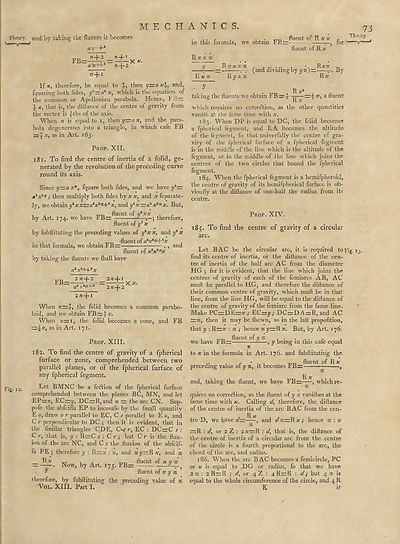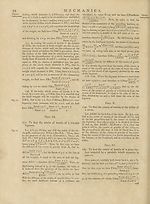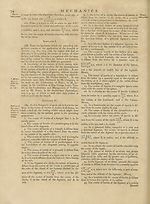Encyclopaedia Britannica, or, a Dictionary of arts, sciences, and miscellaneous literature : enlarged and improved. Illustrated with nearly six hundred engravings > Volume 13, MAT-MIC
(81) Page 73
Download files
Complete book:
Individual page:
Thumbnail gallery: Grid view | List view

M E C FI A N I C S.
Theory, and by taking the fluents it becomes
* ax +*
Fig. 12.
FB=r
n 2 a i
« atH-1 n-\- 2
n~hI
X *•
and
FB=
2 a —2
a* y'n U'
2/2 + 1
2/Z + 2
X
When n—\, the folid becomes a common parabo¬
loid, and we obtain FBrr| ;r.
When n—\, the folid becomes a cone, and FB
as in Art. 171.
Prop. XIII.
182. To find the centre of gravity of a fpherical
furface or zone, comprehended between two
parallel planes, or of the fpherical furface of
any fpherical fegment*
Let BMNC be a feftion of the fpherical furface
comprehended between the planes BC, MN, and let
EP=a?, EC—y, DCrzR, and a rr the arc CN. Sup-
pofe the abfcifla EP to inereafe by the fmall quantity
E 0, draw 0 r parallel to EC, C r parallel to E 0, and
C r perpendicular to DC 5 then it is evident, that in
the fimilar triangles CDE, Cv r, EC : DCzrC s :
C r, that is, ij : Rt=C r : C r ; but C r is the flux¬
ion of the arc NC, and C r the fluxion of the abfcif-
fa PE 5 therefore y : Rzr.v : 55, and zyrzR x, and a
R * XT , . fluent oi x 11 % ,
= . Now, by Art. 17 c. FB= ^—
y fluent o{ x y %
therefore, by fubftituting the preceding value of ss
Vol. XIII. Part I.
in this formula, we obtain FB—
fluent of R x x
fluent of R a;
R .v .v 2;
Ft AC «
R v x x %
If n, therefore, be equal to then y=® arid,
fquaring both Tides, if—a* x, which is the equation of
the common or Apollonian parabola. Hence, F.3—
^ x, that is, the diltance of the centre of gravity from
the vertex is -l-ths of the axis.
When n is equal to 1, then y~a x, and the para¬
bola degenerates into a triangle, in which cafe FB
rzy.v, as in Art. 165.
Prop. XII.
181. To find the centre of inertia of a folid, ge¬
nerated by the revolution of the preceding curve
round its axis.
Since y=o xn, fquare both fides, and we have y2—
m2x2n ; then multiply both fides by x x, and x feparate-
ly, we obtain y*xxzza2x2n-\-tx, and y2x—a2 a?1® x. But,
, . , fluent of w* a; a; , .
by Art. 174. we have r B— —r-; therefore,
fluent of y2Af
by fubftituting the preceding values of y2x x, and if x
. r , , . „„ fluent of a2x2n-\'2x
m that formula, we obtain rBzz .,
fluent of a2x2nx
by taking the fluents we ftiall have
a2x2n-V2x
2/2 + 1
R y a; a
r (and dividing by y 2):
Rata?
for
By
73
Theory.
y
R a;*
taking the fluents wre obtain FB=r 4- 'jfTT—^ x’ a
which requires no correftion, as the other quantities’
vamih at the fame time with x.
183. When DP is equal to DC, the folid becomes
a fpherical fegment, and EA becomes the altitude
of the fegment, fo that universally the centre of gra¬
vity of the fpherical furface of a fpherical fegment
is in the middle of the line which is the altitude of the
fegment, or in the middle of the line which joins the
centres of the two circles that bound the fpherical
fegment.
184. When the fpherical fegment is a hemifpheroid,
the centre of gravity of its hemifpherical furface is ob-
vioufly at the diftance of one-half the radius from its
centre.
Prop. XIV.
185;. To find the centre of gravity of a circular
arc.
Let BAG be the circular arc, it is required to Fig. 13.
find its centre of inertia, or the diftance of the cen¬
tre of inertia of the half arc AC from the diameter
HG ; for it is evident, that the line which joins the
centres of gravity of each of the femiarcs AB, AC
muft be parallel to HG, and therefore the diftance of
their common centre of gravity, which muft be in that
line, from the line HG, will be equal to the diftance of
the centre of gravity of the femiarc from the fame line. '
Make PC—DE—a; ; EC=y; DC=DA=R, and AC
rrs;, then it may be ftiewn, as in the laft propofition,
that y : Rzza: : z ; hence % y=R x. But, by Art. 176.
. fluent of w 55 , . ... r ,
we have I B— , y being in this cale equal
to x in the formula in Art. 176. and fubftituting the
. r • . t fluent of Ra?
preceding value 01 y as, it becomes rB= ,
R 9C
and, taking the fluent, we have FB=-^—, which re¬
quires no corredtion, as the fluent of y sz vaniflies at the
fame time with x. Calling </, therefore, the diftance
of the centre of inertia of the arc BAC from the cen-
R x
tre D, we have 2/— , and d zzzR x : hence z : x
z
zrR : 2/, or 2 Z : 2A:=rR : 2/, that is, the diftance of
the centre of inertia of a circular arc from the centre
of the circle is a fourth proportional to the arc, the
chord of the arc, and radius.
186. When the arc BAC becomes a femicircle, PC
or x is equal to DG or radius, fo that we have
2 2; : 2 R=R ; 2/, or 4 Z : 4 R=R : d; but 4 2; is
equal to the whole circumference of the circle, and 4 R
K ‘ is
Theory, and by taking the fluents it becomes
* ax +*
Fig. 12.
FB=r
n 2 a i
« atH-1 n-\- 2
n~hI
X *•
and
FB=
2 a —2
a* y'n U'
2/2 + 1
2/Z + 2
X
When n—\, the folid becomes a common parabo¬
loid, and we obtain FBrr| ;r.
When n—\, the folid becomes a cone, and FB
as in Art. 171.
Prop. XIII.
182. To find the centre of gravity of a fpherical
furface or zone, comprehended between two
parallel planes, or of the fpherical furface of
any fpherical fegment*
Let BMNC be a feftion of the fpherical furface
comprehended between the planes BC, MN, and let
EP=a?, EC—y, DCrzR, and a rr the arc CN. Sup-
pofe the abfcifla EP to inereafe by the fmall quantity
E 0, draw 0 r parallel to EC, C r parallel to E 0, and
C r perpendicular to DC 5 then it is evident, that in
the fimilar triangles CDE, Cv r, EC : DCzrC s :
C r, that is, ij : Rt=C r : C r ; but C r is the flux¬
ion of the arc NC, and C r the fluxion of the abfcif-
fa PE 5 therefore y : Rzr.v : 55, and zyrzR x, and a
R * XT , . fluent oi x 11 % ,
= . Now, by Art. 17 c. FB= ^—
y fluent o{ x y %
therefore, by fubftituting the preceding value of ss
Vol. XIII. Part I.
in this formula, we obtain FB—
fluent of R x x
fluent of R a;
R .v .v 2;
Ft AC «
R v x x %
If n, therefore, be equal to then y=® arid,
fquaring both Tides, if—a* x, which is the equation of
the common or Apollonian parabola. Hence, F.3—
^ x, that is, the diltance of the centre of gravity from
the vertex is -l-ths of the axis.
When n is equal to 1, then y~a x, and the para¬
bola degenerates into a triangle, in which cafe FB
rzy.v, as in Art. 165.
Prop. XII.
181. To find the centre of inertia of a folid, ge¬
nerated by the revolution of the preceding curve
round its axis.
Since y=o xn, fquare both fides, and we have y2—
m2x2n ; then multiply both fides by x x, and x feparate-
ly, we obtain y*xxzza2x2n-\-tx, and y2x—a2 a?1® x. But,
, . , fluent of w* a; a; , .
by Art. 174. we have r B— —r-; therefore,
fluent of y2Af
by fubftituting the preceding values of y2x x, and if x
. r , , . „„ fluent of a2x2n-\'2x
m that formula, we obtain rBzz .,
fluent of a2x2nx
by taking the fluents we ftiall have
a2x2n-V2x
2/2 + 1
R y a; a
r (and dividing by y 2):
Rata?
for
By
73
Theory.
y
R a;*
taking the fluents wre obtain FB=r 4- 'jfTT—^ x’ a
which requires no correftion, as the other quantities’
vamih at the fame time with x.
183. When DP is equal to DC, the folid becomes
a fpherical fegment, and EA becomes the altitude
of the fegment, fo that universally the centre of gra¬
vity of the fpherical furface of a fpherical fegment
is in the middle of the line which is the altitude of the
fegment, or in the middle of the line which joins the
centres of the two circles that bound the fpherical
fegment.
184. When the fpherical fegment is a hemifpheroid,
the centre of gravity of its hemifpherical furface is ob-
vioufly at the diftance of one-half the radius from its
centre.
Prop. XIV.
185;. To find the centre of gravity of a circular
arc.
Let BAG be the circular arc, it is required to Fig. 13.
find its centre of inertia, or the diftance of the cen¬
tre of inertia of the half arc AC from the diameter
HG ; for it is evident, that the line which joins the
centres of gravity of each of the femiarcs AB, AC
muft be parallel to HG, and therefore the diftance of
their common centre of gravity, which muft be in that
line, from the line HG, will be equal to the diftance of
the centre of gravity of the femiarc from the fame line. '
Make PC—DE—a; ; EC=y; DC=DA=R, and AC
rrs;, then it may be ftiewn, as in the laft propofition,
that y : Rzza: : z ; hence % y=R x. But, by Art. 176.
. fluent of w 55 , . ... r ,
we have I B— , y being in this cale equal
to x in the formula in Art. 176. and fubftituting the
. r • . t fluent of Ra?
preceding value 01 y as, it becomes rB= ,
R 9C
and, taking the fluent, we have FB=-^—, which re¬
quires no corredtion, as the fluent of y sz vaniflies at the
fame time with x. Calling </, therefore, the diftance
of the centre of inertia of the arc BAC from the cen-
R x
tre D, we have 2/— , and d zzzR x : hence z : x
z
zrR : 2/, or 2 Z : 2A:=rR : 2/, that is, the diftance of
the centre of inertia of a circular arc from the centre
of the circle is a fourth proportional to the arc, the
chord of the arc, and radius.
186. When the arc BAC becomes a femicircle, PC
or x is equal to DG or radius, fo that we have
2 2; : 2 R=R ; 2/, or 4 Z : 4 R=R : d; but 4 2; is
equal to the whole circumference of the circle, and 4 R
K ‘ is
Set display mode to:
![]() Universal Viewer |
Universal Viewer | ![]() Mirador |
Large image | Transcription
Mirador |
Large image | Transcription
Images and transcriptions on this page, including medium image downloads, may be used under the Creative Commons Attribution 4.0 International Licence unless otherwise stated. ![]()
| Permanent URL | https://digital.nls.uk/192662215 |
|---|
| Attribution and copyright: |
|
|---|
| Description | Ten editions of 'Encyclopaedia Britannica', issued from 1768-1903, in 231 volumes. Originally issued in 100 weekly parts (3 volumes) between 1768 and 1771 by publishers: Colin Macfarquhar and Andrew Bell (Edinburgh); editor: William Smellie: engraver: Andrew Bell. Expanded editions in the 19th century featured more volumes and contributions from leading experts in their fields. Managed and published in Edinburgh up to the 9th edition (25 volumes, from 1875-1889); the 10th edition (1902-1903) re-issued the 9th edition, with 11 supplementary volumes. |
|---|---|
| Additional NLS resources: |
|

